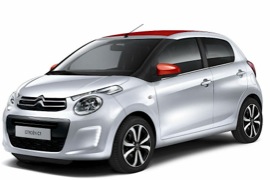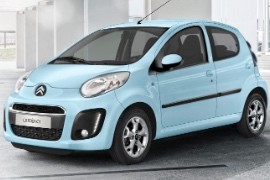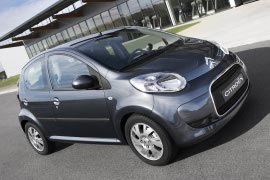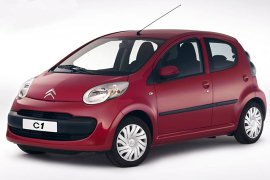CITROEN C1 5 Doors Models/Series Timeline, Specifications & Photos
First production year: 2005
Engines: Gasoline, Diesel
Body style: Hatchback
The PSA french group made a joint-venture with Toyota to build a small city-car. The result was a trio: the Citroen C1-Peugeot 108-Toyota Aygo. All three vehicles were built on the same factory, but with some aesthetic differences. That was a cross-brand badge-engineering.
For the 2014 triplets, the PSA and Toyota agreed to make a different styling so that the buyers will feel like they had a choice. The C1 was allowed to have the “angry” face, with headlights narrower on the inside, the bigger trapezoidal grille and somehow more aggressive lines on the hood. In the rear, the taillights were conventional.
Inside the cabin, there is enough room for the front seats and somehow limited for the rear passengers. The very short wheelbase, of just 2.3 m (92.1”) didn't allow too much room. But for short in-city trips, is fine. The C1 can also receive a soft roof, that will transform the car into a top-cabriolet. The dashboard is plain and simple, with a 7” infotainment unit placed on the center console. It has a screen-mirroring with the smartphone. The same screen is used for the rearview camera.
For the powertrains, the offer is not that much. It had engines ranging between 68 and 82 hp mated either with a 5-speed manual transmission or with an automated gearbox with the same number of gears.
Introduced in 2005, the supermini Citroen C1 was a badge-engineered Toyota Aygo or Peugeot 107, all three of them being built in the Czech Republic on the same assembly lines, and they had to be refreshed along the road. Thus, Citroen released the C1's facelifted version in 2012 and hoped to keep it longer on the market.
Europe was an appropriate market for this kind of supermini vehicle due to the crowded cities, narrow streets, and tiny parking spaces. But the French carmakers were experienced in that area, and that's why they formed a joint-venture with Toyota to build a tiny vehicle able to move four people inside a city and still have enough trunk for two backpacks.
When it refreshed the C1, Citroen chose the same biodesign styling at its foundation. That meant that the headlights were swept toward the A-pillars, and all the front fascia elements were rounded or curved. Even the otherwise edgy Citroen badge, dubbed "Double-chevron," was not as sharp as before. Moreover, the lower grille looked like an open mouth for the 2012 model and was flanked by more obvious air intakes, which also comprised the fog lights. A set of LED daytime running lights was also included in the lower bumper area.
Inside, there were a few important upgrades, such as the paddle-shifters behind the steering wheel, only available with the optional EGS (Electronic Gearbox System). Moreover, in terms of technologies, the 2012 C1 sported a new infotainment unit that was able to read and play MP3 files, CDs, and, on top of that, featured a USB port for music and a 3.5 mm jack.
Under the hood, the carmaker relied on the inline-three gasoline engines, and the turbo-diesel version was axed.
Citroen introduced a facelifted version for its smallest vehicle in the lineup, the C1.
Starting with January 2009, Europe switched to the Euro 5 emission standards, and the carmakers had to comply with the new regulations. The French carmaker introduced the C1 precisely in January 2009, with improved engines and different styling.
The C1 was available in a five- or three-door configuration, but most of their parts were similar. At the front, the facelifted version sported bigger, tear-shaped headlights. The new bumper incorporated a different, mouth-like grille, crossed by a horizontal bar for the license plate. From its sides, the five-door version featured body-colored door handles.
The carmaker tried to upgrade the interior with better materials. There was no instrument cluster apart from the steering-column mounted speedometer. Citroen offered, as an option, an additional dial for the tachometer mounted on top of the speedometer. It was an original, yet unusual, arrangement. In the back, the rear doors sported pop-out, front-hinged windows for the rear passengers. Like its non-facelifted version, the C1 featured a split-folding rear bench, good for two passengers.
Under the hood, Citroen and Toyota developed a new engine management unit that lowered the emissions to fit into the Euro 5 levels. The carmaker offered the vehicle with a manual or a 5-speed automated gearbox. It even offers the car a 1.4-diesel.
The Peugeot-Citroen-Toyota’s love child, the Citroen C1 was unveiled to the public in 2004 at the Geneva Motor Show
The joint venture’s attention was turned towards the mini segment and it was a great deal for everyone involved, sharing knowledge and costs to develop three of the most loved city cars: Citroen C1, Toyota Aygo and Peugeot 107.
For Citroen, the C1 was considered to have replaced the Citroen Saxo which was discontinued in 2004 after a lifetime of 8 years.
Citroen adopted a style with rounded headlights, extended on the sides with the turn-signals. The double-chevron chromed badge adorned its short hood, and the grille was moved to the lower side of the bumper. A black, plastic mold protected the car from small parking bumps. It was notorious how the French drivers used to make room in the parking lots by pushing other vehicles.
Inside, depending on the trim-level, the C1 featured a tachometer mounted on top of the speedometer. Citroen installed both of them on the steering column assembly. The center stack's simple layout allowed easy use of the HVAC controls—the C1 featured power windows at the front and fixed windows in the rear.
Under the hood, Toyota provided the 1.0-liter gasoline engine and PSA (Peugeot-Citroen Group) the 1.4-diesel version. Both versions were paired as standard to a 5-speed manual, while a 5-speed automated version was available as an option. The latter consisted of a manual gearbox and a computer-controlled clutch-actuator system.



